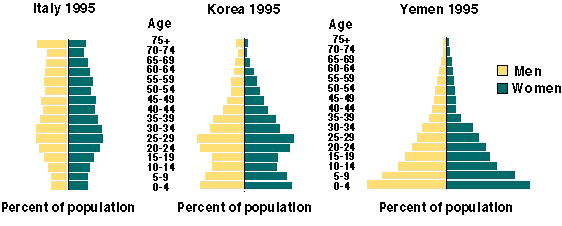|
|
| |

| Exploring Charts 3.1 & 3.2 |
Test Yourself |
1. Study the information in Chart 3.1 for low- and high-income economies in 1995. Then, answer the following questions about the population trends shown.
2. Study the information in Chart 3.2 for low- and high-income economies in 2025. Then, answer the following questions about the population trends shown.
3. Read the definition of population momentum in the glossary. Using Charts 3.1 and 3.2 as a reference, in which economic groups and years do you think this phenomenon exists? Why?
4. Look at the shapes of the charts in Charts 3.1 and 3.2. What would a stabilized population look like? Explain.
5. What impact might population momentum have on the care of small children in a country where a large proportion of the childcare duties are performed by daycare centers? What about a population where elderly relatives provide childcare? Who are the caretakers of small children in your country? What effect might population momentum have on these arrangements?
6. What impact might an aging population have on the care of elderly people in a country where a large proportion of these people live in nursing homes or elderly housing? How are elderly people cared for in your country? What impact might an aging population have on this care?
7. Match each of the following descriptions with the country below that illustrates the trend described.

Home
| Site Guide | Modules | What's SD? | SD Post | Resources | About DEP | Feedback| Copyright � 1998
IBRD/The World Bank |
[email protected] |